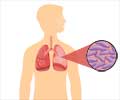
Lead researcher Jason Sello, associate professor of chemistry at Brown, said that ClpP has emerged over the last decade or so as a potential drug target in bacteria because they require it to either live or to cause disease.
He said that their findings indicate that chemical inhibition of the essential ClpP enzyme in Mycobacterium tuberculosis is a viable strategy in anti-tuberculosis drug development.
It degrades and eliminates proteins inside the cell that are misfolded, damaged, or have outlived their usefulness. While ClpP is dispensable in most bacteria, previous research has shown that it is absolutely essential for the viability of M. tuberculosis.
When the gene that makes the protein is knocked out of the bacterium's genome, the organism cannot survive.
The paper has been published online by journal ACS Chemical Biology.
Advertisement














